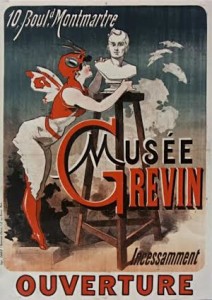 Where Stew Had Not Gone Before
Where Stew Had Not Gone Before
Well, I didn’t think I’d have to venture into the world of image licensing until I was ready to publish the fourth book (Where Did They Put the Gestapo Headquarters?—A Walking Tour of Nazi Occupied Paris: 1940–1944). I wrote a previous blog (Copyrighted Material?) concerning copyright issues but that was before I actually went through the process.
For the first two books (Where Did They Put the Guillotine?—Walking Tours of Revolutionary Paris: 1789–1793), I thought I could get away with using original contemporary photos, images of engravings from my collection, and the original maps created by my friends Tom and Habib at Locomotion Creative.
So Sandy, Dan (our nephew and photographer), and Stephanie (my consultant) spent a whole weekend (about 15-hours) going through all of the images and determining which ones to use in each stop for each walk. Roy (our book designer) told us that we had to have at least one image for each stop.
What I found were a lot of holes
In other words, we didn’t have a photo or an engraving for all the stops I take you to. So I had to fall back on licensing these images. In my previous blog about copyrighted material, I told you about my journey finding out who held the rights to certain images owned by the Musée Carnavalet. So I ended up licensing 55 images through The Image Works.
But even with that, I still had several holes to fill. One of these was the stop where I take you to see Zamor’s house. You say, who the heck is Zamor? He was born in India and slave traders captured him. He was sold to King Louis XV who in turn, gave him to Madame du Barry (Louis XV’s last mistress or “favorite”) as a gift. She took the boy in, raised him as if he were her son, and provided him with a formal education. As a young adult, Zamor became a Revolutionary and was put on one of the committees that would judge and condemn citizens to the guillotine. He turned in Madame du Barry when she came back to Paris (from London as an émigré) to retrieve her diamonds. She was ultimately sent to the guillotine. He fled France and returned in the early 1800s. He became a schoolteacher and died without any friends (everyone knew how he had betrayed Madame du Barry).
Anyway, there were no images of Zamor other than an oil painting done prior to the start of the Revolution. I finally found the company that owned the rights to the painting’s image. I paid through the nose for the license to this image. But it was one of those situations where if I didn’t, you wouldn’t have a picture when you stop at his house (you can thank me later).
Wikimedia Common. Heard of it?
Then there are the images I found on Wikimedia Common. These are all in the public domain. The only problem with these are the resolution levels and will they be good enough for the book. I guess I’ll let Roy worry about that.
So, here’s my tip to you budding authors
To those of you who want to write a book with a lot of images: get ready to pay. Oh, I was going to attach the portrait of Zamor for this blog but it would have cost me more money so you’ll have to settle with the public domain image from Wikimedia Common.
Do we have a lot of stories? Of course we do. I’m looking forward to sharing these with you. Please continue to visit our blog and perhaps subscribe so that you don’t miss out on the most recent blog posts.
Thanks so much for following my blog and my little journey through this incredibly interesting process of writing a series of niche historical travel books and then getting the bloody things published.
-Stew
Please note that I do not and will not take compensation from individuals or companies I mention or promote in my blog.
Are you following us on Facebook and Twitter?
Copyright © 2014 Stew Ross

